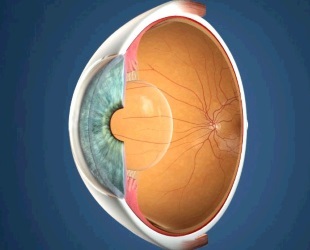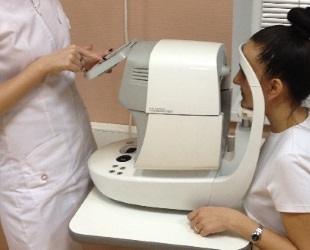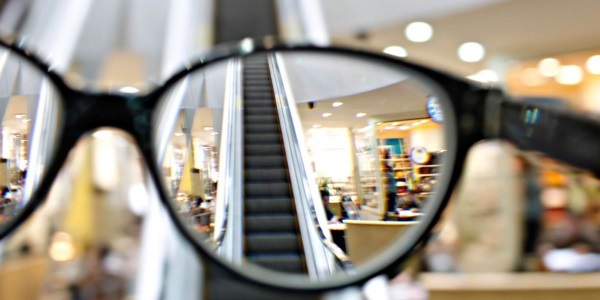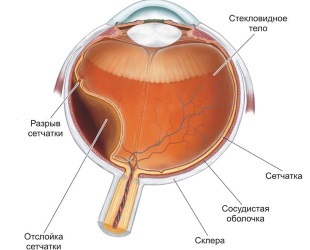
The human eye is a complex natural lens. To this lens all characteristics that determine the properties of other optical systems are applicable.
One such characteristic is refraction, on which the visual acuity and distinctness of the image obtained in the eyes depends.
In other words, refraction is the process of refraction of light rays, which is expressed by the etymology of the word( refractio - "refraction" from Latin).
Refraction refers to the way and degree of change in the direction of the rays passing through the optical system.
- 2. Types of
- 3. Diagnostics of
- 4. Treatment and prevention of
- 5. Results of
- 6. Video of
Introduction to
The unified eye system consists of four subsystems: the two sides of the lens and the two sides of the cornea. Each of them has its own refraction, in its totality they form a general level of refraction of the organ of vision.
Refraction also depends on the length of the axis of the eye, this characteristic determines whether the rays converge on the retina at a given refractive index, or the axial distance is too large or too small for this.
In medical practice, two approaches to measurement of refraction are used: physical and clinical. The first method evaluates the system from the cornea and the lens itself, outside of its connection with other biological subsystems of the eye.

Here, the characteristics of the eyes are evaluated by analogy with all other types of physical lenses, without regard for the specificity of the human vision. The physical refraction in diopters is measured.
Diopters are a measure of the optical power of a lens. This value is inverse to the focal length of the lens( F) - the distance at which the refracted rays converge at one point.
This means that with a focal length of one meter, the refraction force will be equal to one diopter, and the focal length of 0.1 meters( 10 cm) corresponds to a refractive power of 10 D( 1 / 0.1).
The average degree of refraction of a healthy human eye is 60 D( F = 17 mm).
But this characteristic alone is not enough to fully diagnose visual acuity. With the optimal refractive power of the eye lens, a person still can not see a clear image. This is due to the fact that the structure of the eye plays an important role here.
If it is incorrect, the light rays will not get on the retina, even at a normal focal length. Because of this, ophthalmology uses a complex parameter - clinical( statistical) refraction, it expresses the relationship of physical refraction with the length of the eye axis and the location of the retina.
Types
Emmetropic
Emmetropic refraction refers to the refraction of the rays in which the length of the eye axis and the focal length are equal, therefore, the light rays converge exactly on the retina, and the brain receives information about a clear image.
The point of clear vision( the distance from which the rays can focus on the retina) here is fixed to infinity, that is, a person can easily see far-away objects, the possibility of obtaining an image is limited only by their size.
Emmetropia is considered an essential characteristic of a healthy eye, a measurement of visual acuity according to the Sittsev table with such refraction will give a result of 1.0.
Easily given to the emmetropic eye and examination of nearby objects with the help of the refraction of the lens with the accommodation of , but in the elderly, a deterioration of close vision due to weakening of the ciliary muscles and lens loss of elasticity is observed.

Ametropic
The opposite of emmetropia is ametropia. This is a common name for all deviations from the norm of statistical refraction. Ametropia is divided into
- Myopia.
- Hypermetropia.
- Astigmatism.
Such deviations may be caused by an irregular shape of the eyeball, a violation of physical refraction, or both.
Ametropium is measured in diopters, but here this value is expressed not by the physical refraction of the eye itself, but by the degree of refraction of the outer lens, which is necessary to bring the visual acuity into a normal state.
If light refraction is unnecessary, an attenuating, scattering lens that reduces the total number of diopters in the optical system is needed, in which case the degree of ametropia is expressed by a negative number of diopters. If the refraction is insufficient, an amplifying lens is needed, therefore, the number of dioptres will be positive.
Myopia

Myopia or nearsightedness is a violation of refraction, in which the point of clear vision is at a close distance and is getting closer as the pathology progresses.
A person without glasses can see only nearby objects, and consideration of more distant objects is possible only with very strong accommodation tension, in the later stages it is useless also.
The most common cause - this violation of the shape of the eye, the elongation of its central axis, because of what the focus of light rays does not reach the retina.
For the correction of myopia, scattering lenses are needed, so the degree of myopia is expressed by a negative number of diopters. There are three stages in the disease: weak( up to -3 D), medium( -3 to -6 D), heavy( -6 Dpt and more)
Hypermetropia
With hypermetropia( farsightedness), the refraction of the eye is too weak,that their focusing occurs only behind the retina. This can be caused by too short the length of the eye axis, insufficient lens curvature, and the weakness of the accommodation muscles.
The latter cause most often causes senile hyperopia and is not directly related to refraction, since in this case the refractive power of the eye in a calm state is not disturbed.
Contrary to its name, hyperopia does not suggest the long-range location of the point of clear view, moreover, it is generally imaginary, that is, absent.
The great simplicity of consideration of distant objects in hypermetropia is related not to the optimal refraction of the rays emanating from them, but to the relative simplicity of their accommodation in comparison with the accommodation of light rays from nearby objects.
Because hyperlipropy requires reinforcing lenses, the severity of the disorder is expressed in positive diopters. Stages of the disease: early( +3 +3), medium( +3 to +8 D), heavy( more than +8 D).
Astigmatism
Astigmatism is characterized by different indices of refraction on the meridians of the eye, that is, differing in the degree of refraction in each part of the organ of vision. Different combinations are possible: short-sightedness on some meridians and emmetropia on others, different stages of myopia or farsightedness on each meridian and so on.
The manifestations of all forms of astigmatism are characteristic - the clarity of vision is disrupted when considering objects of any removal. The degree of pathology is determined by the difference in diopters of maximum and minimum refraction on the meridians.
Diagnostics
For the diagnosis of refractive abilities, it is important to minimize accommodation, which can obscure refractive errors in the early stages. This is especially true in the diagnosis of hyperopia.
The most reliable way to turn off accommodation is cycloplegia, which consists in dropping into the eyes solutions of atropine or scopolamine and in the subsequent examination of visual acuity using standard tables.
If a person can not independently view the image, he is given different lenses until a lens is found that provides a clear picture. The degree of refraction of this lens determines the statistical refraction of the eye.
Sometimes( for example, to test for presbyopia), it becomes necessary to perform refractive error diagnostics taking into account accommodation, this refraction will be called dynamic.
Subjective methods have one drawback: the possibility of a clear image viewing depends not only on refraction, but also on a number of other factors. Sittsev's tables are remembered by many people by heart because of the frequency of checks on them, and even with poor eyesight they can easily name the lower series of letters, since the brain will finish their outlines from memory.
Objective methods minimize the subjective factor and analyze the refraction of the eyes based only on their internal structure. High efficiency among such methods is possessed by measuring the refraction of light by the organs of vision with the help of a refractometer. This device sends to the eye harmless infrared signals and determines their refraction in the optical environment.
A more simple objective method is a skiascopy, with the ophthalmologist directing light rays through the eyes in the eye and monitoring the dropping of the shadow. According to this shadow, a conclusion is drawn about statistical refraction.
The most accurate and costly procedures are represented by ultrasonic examination and keratography, these methods allow one to examine in detail the refraction at each meridian, to accurately determine the length of the ocular axis and to examine the surface of the retina.
Treatment and prevention of

The most basic and necessary of the treatment methods is the selection of corrective external lenses.
This is necessary in all cases, except for a short-term reduction in severity due to overexertion, there are enough general preventive measures.
Depending on the aesthetic preferences, you can choose glasses or contact lenses.
More radical treatments are represented by laser correction. Most of all, myopia is subject to surgical correction, but early stages of hyperopia and astigmatism can also be cured with such correction.
Medical treatment is effective as a supporting therapy in the application of surgical methods.
Prevention of visual acuity disturbances consists in the correct arrangement of the workplace, in ensuring optimal lighting, in observing the regime of the day and work, and preventing overtraining. A great benefit is regular gymnastics for the eyes, which relaxes them and gives them a tone. It is important to provide the body with all the necessary vitamins and minerals.
In many respects, the health of the eyes is affected by their constant overstrain. This can be avoided by performing gymnastics and special exercises:
- Gymnastics for Zhdanov
- Tibetan method of vision recovery
- Charge for eyes
Results of
Refraction is the refraction of rays by an optical system. To assess the optical system of the human eye, the physical and clinical approaches to measuring refraction are used. The physical approach measures the strength of the eye's refraction without regard for its relation to the internal arrangement of the organ.
The clinical approach complements the physical and evaluates the ratio of the refractive power to the length of the eye axis and the structure of the retina. The refractive power of light is measured in diopters. Refraction has three types: emmetropia, myopia and hypermetropia. Astigmatism is also distinguished, characterized by a different degree of refraction in each part of the eye.
Video
We present to your attention the following video:
